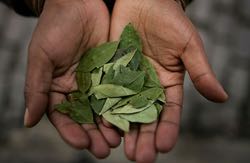Coca cultivation in Bolivia has reached its lowest levels since United Nations monitoring began in 2003, moving the country closer to policy makers’ de facto cap on coca crops. But as transnational drug trafficking intensifies, the world’s third-largest coca producer remains under pressure to do more.
The area of land dedicated to coca leaf cultivation in Bolivia declined from 20,400 hectares in 2014 to 20,200 in 2015, a drop of 1 percent, according to a report (pdf) from the United Nations Office on Drugs and Crime (UNODC).
Seizures of illicitly grown coca leaves fell by 38 percent, from nearly 600 tons in 2014 to just under 400 tons in 2015, and coca base seizures dropped by 31 percent, from 20 tons to just under 14 tons.
But cocaine powder seizures more than doubled, growing 111 percent from 4.5 tons in 2014 to just under 9.5 tons in 2015, and eradication fell by 1 percent year on year, from 11,144 hectares to 11,020.
Bolivia has taken a different approach in tackling its drug production problem than other South America countries such as Colombia and Mexico. President Evo Morales — himself a former coca farmer — works with local coca growers rather than criminalizing them.
Since 2004, the government has allowed registered farmers small, legal “traditional” cultivations amounting to a total of 12,000 hectares, via its Ley 1008. A study on coca use later found that more coca is needed to satisfy the local market — in which people chew the leaves or use them as medicine — and recommended increasing the hectare cap to 14,705.
SEE ALSO: Evo’s challenge — Bolivia the drug hub
Experts say the Morales administration is targeting a de facto goal of 20,000 hectares, and these latest UN cultivation figures indicate they are not far off the mark. Their plan assumes the legal market for coca can expand to absorb that resulting coca crop, although the scheme’s detractors would argue that it leaves some 8,000 hectares of excess coca likely to seep into the illegal drug-trafficking industry.
Proponents of the experimental strategy — the only one of its kind in the region — say that it represents the first time that those in charge of coca control understand and account for the needs of the farmers and their communities.
Kathryn Ledebur, Director of the Andean Information Network (AIN) and co-author of the report, “Habeas Coca: Bolivia’s Community Coca Control,” told InSight Crime last year that the bureaucracy involved in policing the crops beats the violence and repression generated by militarized anti-drug campaigns.
But US and Bolivian authorities have clashed over the Andean nation’s coca strategy, especially as Bolivia is increasingly becoming a regional drug-trafficking hub that doesn’t just cultivate coca, but is a major cocaine producer and a transit country for cocaine and other drugs destined for other countries in the region, as well as for the United States, Europe and Asia.
InSight Crime Analysis
The most recent US State Department figures differ greatly from those published by the United Nations. There is no US statistic yet for 2015, but for 2014 the International Narcotics Control Strategy report estimated that there were 35,000 hectares of coca cultivation in Bolivia in 2014 — some 15,000 more than the UN suggests.
The Obama administration has, in fact, blacklisted Bolivia for what it describes as a “lack of sufficient cooperation on counternarcotics activities and for failing to maintain adequate controls over licit coca markets.” (International Narcotics Control Strategy).
The US shut down its anti-narcotics office there in 2013, and relations between the two countries have been rocky ever since President Morales expelled the Drug Enforcement Administration’s (DEA) personnel in 2009.
The European Union was running parallel programs in Bolivia when the US was still active there, and when it pulled out in 2013 the EU pledged $33.4 million in further assistance that employed a more holistic anti-drug approach, involving development projects such as incentivizing the production of alternative crops. The EU approach is more in line with the nation’s own policy.
But the European approach — which naturally seeks to reduce the amount of Bolivian cocaine arriving on European shores — fails to address the weaknesses of Bolivia’s security forces. That said, President Morales has since the beginning of 2016 made efforts to toughen Bolivia’s stance against the illicit cocaine industry in the country and the growing presence of transnational drug-trafficking organizations. He has moved to strengthen control of the landlocked country’s borders.
Anti-narcotic agents have found more than 1,000 clandestine airstrips in the last three years along Bolivia’s borders with Peru and Brazil, and more cocaine laboratories within Bolivian territory — a sign of growing transit and increased production.
In May 2016, Bolivia and Peru signed an agreement to try to close down the air bridge linking the two countries’ trafficking organizations, via which an estimated 200 tons of cocaine is flown into Bolivia every year from Peru. Bolivian and Brazilian authorities are also working together more.
Ledebur told InSight Crime in a phone interview that she thinks these fresh cultivation figures come amid interdiction efforts by the Bolivian government, and the country’s new agreements with its neighbours support her argument.
“It’s tacit recognition on the part of all governments that the DEA doesn’t hold the silver bullet to making this work,” Ledebur said.

